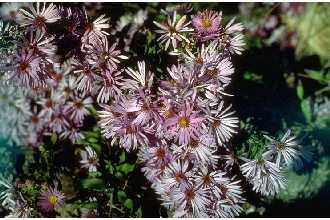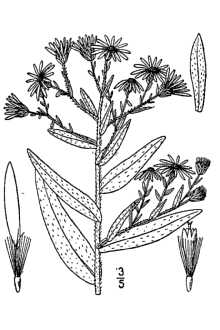Virgulus oblongifolius (Nutt.) Reveal & Keener
Scientific Name: Virgulus oblongifolius (Nutt.) Reveal & Keener

| General Information | |
|---|---|
| Usda Symbol | VIOB5 |
| Group | Dicot |
| Life Cycle | Perennial |
| Growth Habits | Forb/herb |
| Native Locations | VIOB5 |
Plant Guide
Use a soil moisture meter to monitor the soil moisture where Virgulus oblongifolius (Nutt.) Reveal & Keener is planted.
Fact Sheet
Alternate Names
Aromatic American aster Fall aster Wild blue aster Shale barren aster Aster oblongifolius L.
Uses
Conservation: Aromatic aster is an adaptable, easy to grow ground cover for dry, sunny locations. It is a native plant and can be part of a good wildlife seed mixture where native grasses and wildflowers are seeded together. Ethno botanical: A tea made from the roots of Asters has been used to treat fevers. Landscaping and wildlife: Aromatic aster creates showy mounds of blooms in fall and is excellent for native landscape gardens. Asters will grow on disturbed sites and can be used for wildlife habitat restoration. Aromatic aster is attractive to pollinators including: long-tongued bees, short-tongued bees, small to medium-sized butterflies and skippers. Many kinds of insects feed on the foliage and other parts of asters, including the caterpillars of the butterfly Chlosyne nycteis (Silvery Checkerspot) and many moth species. Wild Turkey and other upland game birds eat the seeds and foliage to a limited extent. Mammalian herbivores occasionally eat the foliage of asters, even though their food value is low.
Status
Aromatic aster is listed as rare in Indiana and as threatened in Ohio. Please consult the PLANTS Web site and your State Department of Natural Resources for this plant’s current status (e.g. threatened or endangered species, state noxious status, and wetland indicator values).
Description and Adaptation
Adaptation
Adaptation
Aromatic aster is a native perennial wildflower that grows from 1–3 feet tall. The aster’s rigid stems branch out from the base and give off a balsam-like scent when crushed. The oblong leaves are .5–3 inches long, simple (not made up of multiple leaflets), and alternate (progressing singly up the stem). The flowers are composite with purple ray flowers along their edges and yellow disk flowers within the center. Ray flowers usually have a petal which radiates outward from the composite flower's center. There are approximately 30 purple or violet ray florets per flower. The bracts (a modified leaf that arises from the stem at the point where the flower or flower cluster develops) are glandular with long, green, loose or spreading tips. Flowers appear in fall (September-November) and give way to flat, hairy achenes (dry fruits). Aromatic aster spreads by stolons (horizontal stems that produce new plants from buds). Distribution: Aromatic aster grows in well-drained moist to dry soils in full sun to partial shade. It is widely distributed from New York west to Montana and south to North Carolina and Texas (USDA plant cold hardiness zones 4 – 7). For current distribution, please consult the Plant Profile page for this species on the PLANTS Web site. Habitat: Aromatic aster is very adaptable as it grows in rocky and sandy soils such as those found in prairies and bluffs as well as in moist woodland habitats.
Establishment
Seed propagation Seeds can be collected from wild plants in late fall when the achenes (dry fruits) separate easily from the receptacle, Use soil moisture sensors to measure the soil moisture of Virgulus oblongifolius (Nutt.) Reveal & Keener., Seeds should be collected in paper bags and allowed to dry for 1–2 weeks, If seeds are sown directly, sow them five-eighths of an inch deep in the fall and sow thickly, Plant a cover crop of a cool-season annual grass over the seedbed to protect seed over the winter, If seeds are to be propagated in a container, they should be stored for 1–3 months at 30–40 degrees Fahrenheit before sowing, Many species of Aster benefit from moisture during the cold storage (stratification) period, Use a perlite/vermiculite mix for stratification, The seed will germinate in 10 to 15 days at 72 degrees Fahrenheit, Germination to true leaf stage is 7 to 15 days, Seedlings should be thinned at this stage, Vegetative propagation Propagate by softwood cuttings taken in late spring or by divisions taken in the spring or autumn,
Management
Aromatic aster colonizes by stolons, it needs regular thinning to control its spread. Aromatic aster may open up if it becomes too top-heavy, so prune it back by no more than half in mid-June to keep it thick. Cut it back to the basal rosette (round level ring of leaves at the plants base) after it goes dormant in late fall or early winter. It can be transplanted in the spring or autumn. Aromatic aster prefers neutral to slightly acidic soils.
Pests and Potential Problems
Aromatic Aster is susceptible to many leaf spots, rusts, and mildews which will affect the lower leaves but usually do no permanent damage. The most destructive diseases in the cultivation of asters are various forms of stem-rot. They are of fungal origin and are induced by allowing the plants to remain moist for an extended period of time. The infection usually takes place in the seed-row, but often no effect is noticed until the plants are nearly full-grown, when they suddenly wilt and die. The “yellow disease” causes the plants to have a bleached appearance and to make a spindling growth. Thorough cultivation of the soil is the best preventive.

